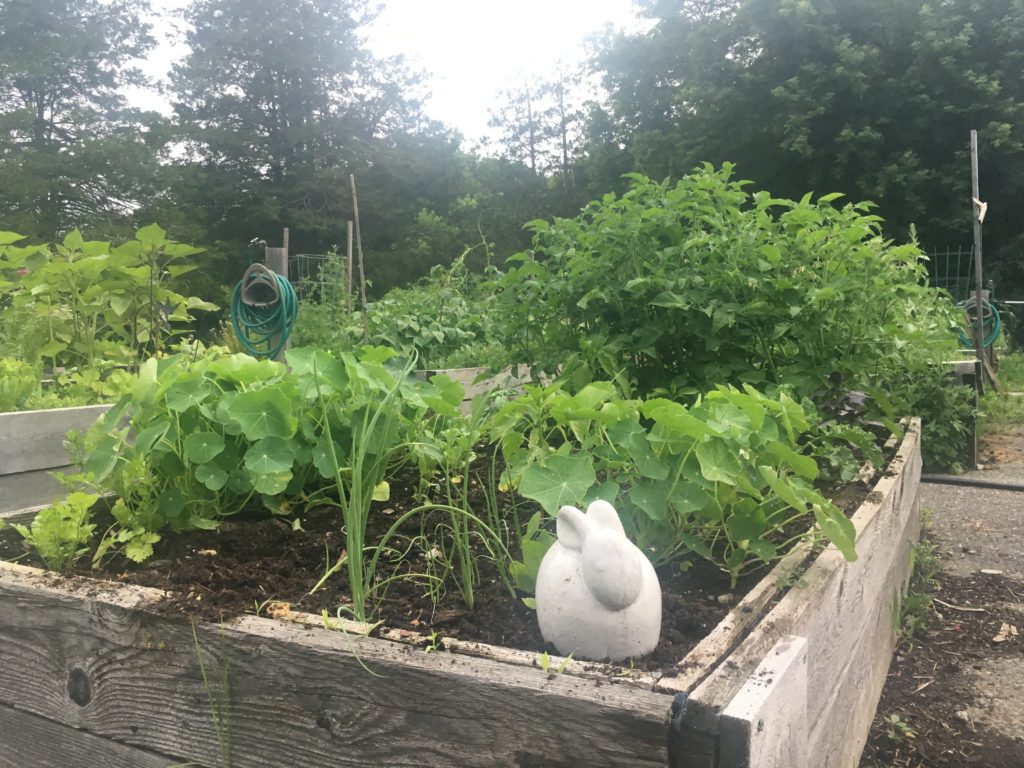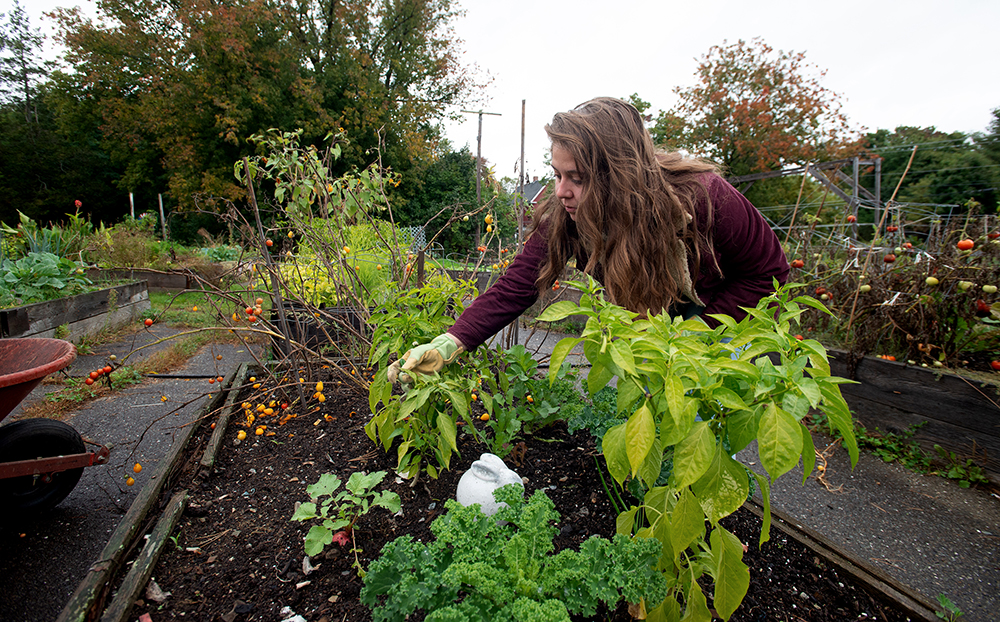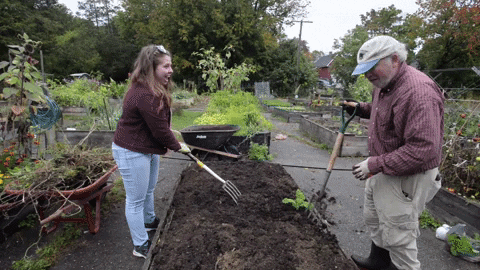I tried to prep my raised bed garden for winter. Here’s how it went.

When I moved to Bangor last winter, I had no idea where I was going to garden in the spring. My second-floor apartment on the outskirts of Little City was sunny enough to grow seedlings, but the “yard” was used as a shared driveway. I finagled a container garden set-up on my outdoor stairs, but I had grander gardening dreams than the space allowed. So, for the first time, I decided to sign up for a raised bed garden in the Bangor Community Garden.
Though I had never participated in a community garden, I knew about some of their benefits. A 2012 study at the University of Pennsylvania found that greening vacant lots in Philadelphia with community gardens may reduce crime in the area surrounding the lot. Aside from the regular physical and mental health benefits of gardening, a 2013 study showed that community gardens improve food security and increase fruit and vegetable intake of their participants. Families also reported feeling closer after working in community gardens together.
I leased my 32-square-foot patch of green in the Bangor Community Garden on Essex Street from the Bangor Parks and Recreation Department. Before that area was a community garden, the land served as a dump, a Navy Reserve Center and then a vacant city lot. The empty blacktop was filled with 56 raised beds in 2011. Now, the garden boasts over 200 raised beds — and, this year, one of them had my name on it.
Over the course of the season, I grew cherry tomatoes, peppers, kale, spinach, radishes, nasturtium, basil, cilantro and green onions in my raised bed. More than that, though, I befriended the charming denizens of the community garden. The pre-teen who lives next door to the community garden would bike over to help me pull radishes when she saw me drive in. Byron Hale, the garden’s volunteer property manager, was always there to chat when I went to weed and water. Lately, he has been texting me updates about his prized pumpkins as he prepares to compete in the Damariscotta Pumpkinfest and Regatta.
The community garden helped me feel more at home in my new city. Now, winter is coming and it is time to put my raised bed to bed.
Learning to try
Before I headed over to the Bangor Community Garden for one last time this season, I discussed how to prepare a raised bed for winter with Kate Garland, horticultural specialist at the University of Maine Cooperative Extension.
We went over the importance of tending to a garden plot before the winter. Not only does it help stave off disease in the season to come, but it also reduces the chores you have to do come spring when you are excited to plant.
Kate reviewed the basic steps with me: removing the last remaining harvest, removing dead plants, weeding, adding compost, planting cover crops or adding mulch, taking care of perennials, planting overwintered crops and adding season extenders.
Kate also recommended taking a soil sample from the raised bed now instead of in the spring. The cooperative extension is less busy in the fall, and having the results early gives you more time to add the necessary amendments before you plant in the spring.
Kate’s tips provided a helpful roadmap, but I wondered how her instructions would differ in a community garden setting. According to the Bangor Community Garden membership agreement, permanent structures are not allowed on plots, so that ruled out setting up hoop houses or other season extenders for next year. I also did not plant any perennials because, according to the same bylaws, community gardeners must remove all plant materials from their raised beds at the end of the season.
This, of course, made me wonder — would I be allowed to plant garlic in my community garden plot to overwinter? Could I sow a cover crop?

I didn’t know the answers, but I knew who would: I called Byron up and asked him to meet me at the community garden on a rainy Wednesday morning. He excitedly agreed.
A trying experience
One advantage of preparing a community garden plot for winter is that they often provide the essential materials. The Bangor Community Garden is fully equipped with quality compost and tools (Byron did enlist me to help with another winter garden prep task in a few weeks: tool cleaning). Just because Byron is a pal, he also picked up some oats to use as a cover crop, garlic to overwinter and a mail-in soil sample box from the cooperative extension. I guess that answered my lingering questions.
Then, we got to work.
We started by harvesting the remaining crops. I forgot my basket, but Byron had some plastic grocery bags that we were able to repurpose. The harvest was hardly bountiful — a few skinny scallions, some misshapen radishes, half-ripe cherry tomatoes and stumpy curly kale.
Then, we removed the dead plants. The root structures surprised me: my peppers barely went below the surface, but my tomatoes reached all the way across the bed. Byron teased (with reason) that it was because I did not water my crops enough. The tomato roots, he explained, were desperately searching for water. I promised him I would do better next year.
Byron and I also removed the rotting tomatoes that had dropped off my plants into the soil. Embarrasingly, there were many. I had a lot of tomatoes split and fall (due to the aforementioned underwatering). I was quite lazy about disposing of the remains because I was busy with the summer’s bumper cherry tomato harvest (much like my boss — and fellow community gardener — Sarah Walker Caron).

Next, every gardener’s favorite task: weeding. As Kate explained, weeding is important this time of year because this is when weeds will set seed. Byron pointed out some sneaky weeds sprouting around the base of my bed and between the splits in the wood. I absolutely would have forgotten them otherwise.
After all the weeds were gone, we added the compost. My wheelbarrow dexterity is poor, so Byron brought the compost over from the communal pile. He poured it over my raised bed — enough for a two-inch-thick layer of compost spread over top — and we mixed it in.
Then, we took soil samples from around the bed, mixed them together and shoveled them into the mail-in box. I told Byron I would let him know when I got the results. He showed me some of the amendments that I might need after I learn what my soil is missing, but community gardeners are required to provide their own amendments.

After that, we picked a little corner to plant cloves of garlic to overwinter for harvesting in the spring. Byron reminded me to sign up for the same community garden bed next year (if you know which plot is mine, I implore you, do not steal my garlic). I planted the cloves, watered them in and covered the area with a straw mulch.
Finally, we scattered a cover crop over the plot. Byron picked oats because he knows I am a forgetful (and sometimes, I’ll admit, lazy) gardener. Oats die back during the winter, so I will not need to clear the crops in the spring, as with other cover crops like winter rye.

Finally, we were done. After a little teasing, Byron admitted that I had done a pretty good job for my first year in the Bangor Community Garden.
My tried-and-true takeaways
Preparing a raised garden bed for winter is a time commitment — albeit, a necessary one if you want to have a productive season the following year. Make sure you have all of the necessary materials before you start, and plan to commit at least two hours to the process.
I recommend enlisting an experienced gardener — and friend — to guide you if you can. Many community gardens will also hold fall clean-up days where you can get tips, tricks and — if you’re like me — a little bit of help maneuvering a wheelbarrow.
Preparing a community garden plot for winter is slightly different than preparing a raised bed at home. The community garden may provide you with some of the necessary materials and tools, but be sure to review the guidelines or member by-laws for your community garden before you start.
Plus, at a community garden, they will also hold you accountable to preparing your bed for winter. Bryon sent an email out to all community garden participants reminding them to prepare their beds for winter soon after we finished mine.
